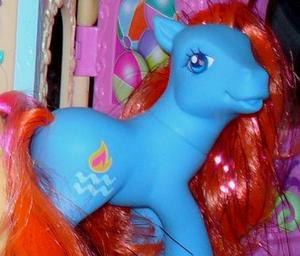As someone who turns up her nose at gender-stereotyped toys and mass-produced plastic commoditites, I would probably be the last grown woman you’d expect to have a My Little Pony collection. While this is something that I generally keep “on the down-low” because it’s, frankly, a sort of odd hobby, I can’t get enough of these cute little plastic horses.
My Little Pony got its start in 1981, when the line was released as My Pretty Pony by the toy manufacturing giant Hasbro. In 1983, it was re-released as My Little Pony, with extra features like the combable hair and the “cutie mark” on the flanks, and a cultural phenomenon was born. Until the original line was retired in 1995, My Little Pony even outperformed Barbie as the biggest little-girl toy obsession. I, naturally, was one of the girls caught in the frenzy.
It is an unexplained, but seemingly global, phenomenon that almost all little girls like horses. Almost every little girl has at some point asked for a pony for Christmas, and girls seem to all get butterflies in their stomachs (and hearts) every time they see a stallion prancing. The appeal is probably partially social conditioning, but partially innate and instinctive.
Like cars, which hold a universal appeal, especially for little boys, horses make children feel empowered. The idea of being in control of– and working in harmony with– a machine or animal many times one’s own size is deeply inspiring. On a horse, a child can be ten feet tall and can fly faster than the wind. To little girls, who are socially conditioned to feel nurturing toward animals, the idea of nurturing and caring for a thousand-pound creature is thrilling. Girls and women rarely feel so utterly empowered.
Hasbro capitalized on this instinct among girls, and shrunk the horse into a much more manageable and lovable size, with all the charm of a horse and all the magic of a fantasy-toy. As a result, My Little Pony displays perhaps the two most selling traits of a children’s toy for girls: glamour and enchantment.
Each individual My Little Pony released by Hasbro, from the original line to the modern “Third Generation” ponies, has its own distinct “cutie mark”, a symbol that usually identifies something about the pony’s name and something about her personality (and, yes, all My Little Ponies appear to be female). These cutie marks are stamped on the pony’s rear flanks and are usually fun, girly images like balloons, paint brushes, hearts, rainbows, flowers, and the like.
Additionally, the individual My Little Pony toys come in a full spectrum of different colors, adding to their collector’s appeal. How can any girl (or woman) feel like her life is complete unless she’s got an indigo pony to sit between her blue and purple toys? The sheer excitement and indivuality of these cute Hasbro figures makes them delighful.
Hasbro was brilliant when they decided to market the My Little Pony line of toys for little girls. There is something inspiring and empowering on an intuitive level about holding an impossible, magical horse in the palm of your hand and imagining that you are nurturing it. Perhaps my love of these little buggers is inspired by mere nostalgia for my childhood, but I can never help but smile when I lay eyes on my impressive rainbow “herd” or posing plastic horses.
Resource: My Little Pony. Hasbro.com. Accessed 31 Dec 08.
